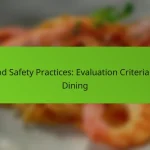In the competitive world of dining, customer service expectations are paramount, focusing on service quality, efficiency, and the overall experience. Guests look for timely and friendly service, accurate orders, and a clean atmosphere, all of which contribute to their satisfaction. To maintain high standards, restaurants must adhere to food safety regulations, implement effective staff training, and regularly assess service quality through various feedback methods.

What are customer service expectations in restaurants?
Customer service expectations in restaurants revolve around the quality of service, efficiency, and overall dining experience. Patrons anticipate timely service, friendly interactions, accurate order fulfillment, a clean environment, and responsiveness to feedback.
Timely service
Timely service is crucial in the restaurant industry, as customers expect their food and drinks to arrive within a reasonable timeframe. Typically, patrons should not wait more than 15-20 minutes for their initial order to be taken and another 20-30 minutes for their meals to be served, depending on the type of establishment.
To ensure timely service, restaurants should maintain adequate staffing levels during peak hours and streamline kitchen operations. Implementing a system for tracking orders can help minimize delays and improve customer satisfaction.
Friendly staff interactions
Friendly staff interactions significantly enhance the dining experience, as customers appreciate a warm and welcoming atmosphere. Staff should greet guests promptly, maintain a positive demeanor, and be attentive to their needs throughout the meal.
Training staff in effective communication and customer service skills can foster these friendly interactions. Simple gestures, such as smiling and making eye contact, can create a more inviting environment and encourage repeat visits.
Accurate order fulfillment
Accurate order fulfillment is essential for customer satisfaction, as incorrect orders can lead to frustration and disappointment. Restaurants should implement measures to ensure that orders are taken and prepared correctly, such as repeating orders back to customers and using clear labeling in the kitchen.
Encouraging customers to double-check their orders before finalizing can also help minimize errors. When mistakes do occur, staff should address them promptly and offer solutions, such as replacing the dish or providing a discount.
Clean and welcoming environment
A clean and welcoming environment is a fundamental expectation for diners. Restaurants should prioritize cleanliness in all areas, including dining spaces, restrooms, and kitchen areas. Regular cleaning schedules and inspections can help maintain high standards.
Additionally, creating a welcoming atmosphere through thoughtful decor, comfortable seating, and appropriate lighting can enhance the overall dining experience. Customers are more likely to return to establishments that prioritize cleanliness and ambiance.
Responsive to customer feedback
Being responsive to customer feedback is vital for improving service and building loyalty. Restaurants should actively seek feedback through comment cards, online reviews, or direct conversations with patrons. This input can provide valuable insights into areas needing improvement.
Establishing a system for addressing feedback, whether positive or negative, demonstrates a commitment to customer satisfaction. Responding to reviews online and making necessary adjustments based on customer suggestions can foster a sense of community and encourage repeat business.

How to measure customer service quality in dining?
Measuring customer service quality in dining involves assessing various aspects of the dining experience, including staff interactions, food service speed, and overall satisfaction. Effective methods include customer satisfaction surveys, online reviews analysis, and mystery shopper evaluations.
Customer satisfaction surveys
Customer satisfaction surveys are a direct way to gauge diners’ experiences and expectations. These surveys can be distributed via email, in-person, or through restaurant apps, typically asking patrons to rate their experience on a scale or provide open-ended feedback.
When designing surveys, focus on key areas such as food quality, service speed, staff friendliness, and overall ambiance. Aim for a response rate of around 10-20% to ensure a representative sample of your customer base.
Online reviews analysis
Online reviews on platforms like Yelp, Google, and TripAdvisor provide valuable insights into customer perceptions of your restaurant. Analyzing these reviews can help identify trends in customer satisfaction and areas needing improvement.
Look for common themes in feedback, such as recurring complaints about service delays or praise for specific menu items. Regularly monitoring your ratings and responding to reviews can enhance your restaurant’s reputation and demonstrate commitment to customer service.
Mystery shopper evaluations
Mystery shopper evaluations involve hiring individuals to dine at your restaurant and assess the service quality anonymously. This method provides an unbiased view of the customer experience and can highlight both strengths and weaknesses in service delivery.
When implementing mystery shopper programs, create a detailed checklist covering aspects like staff behavior, cleanliness, and food presentation. Aim to conduct these evaluations periodically to maintain high service standards and make necessary adjustments based on feedback.

What are the key quality standards for restaurant service?
The key quality standards for restaurant service include adherence to food safety regulations, effective staff training programs, and maintaining service speed benchmarks. These standards ensure a safe, efficient, and pleasant dining experience for customers.
Food safety regulations
Food safety regulations are critical for protecting customers from foodborne illnesses. Restaurants must comply with local health codes, which often include guidelines on food storage temperatures, sanitation practices, and employee hygiene. Regular inspections and certifications help maintain these standards.
For example, in the United States, the Food and Drug Administration (FDA) provides a model code that many states adopt. This code outlines safe food handling practices, which can vary by region but generally emphasize the importance of cooking, cooling, and storing food properly.
Staff training programs
Staff training programs are essential for ensuring that employees understand and implement quality service standards. Effective training covers food safety, customer service skills, and menu knowledge, which can enhance the overall dining experience. Regular refreshers and updates help keep staff informed about new procedures or menu items.
Restaurants often utilize a combination of hands-on training and online modules to accommodate different learning styles. For instance, new hires might shadow experienced staff during busy shifts to learn best practices in real-time.
Service speed benchmarks
Service speed benchmarks refer to the expected time frames for various stages of the dining experience, such as seating, taking orders, and serving food. Establishing these benchmarks helps restaurants manage customer expectations and improve overall efficiency. Typical service speed might range from a few minutes for drinks to around 20-30 minutes for main courses.
To optimize service speed, restaurants can implement strategies like streamlined order-taking systems and efficient kitchen workflows. Monitoring and analyzing service times can help identify bottlenecks and areas for improvement, ensuring a smoother dining experience for guests.

How does customer service impact the dining experience?
Customer service significantly influences the dining experience by shaping guests’ perceptions and satisfaction levels. Positive interactions can enhance enjoyment, while poor service can lead to dissatisfaction and negative reviews.
Influences customer loyalty
Exceptional customer service fosters loyalty among diners, encouraging them to return to the restaurant. When patrons feel valued and well-treated, they are more likely to recommend the establishment to others, creating a strong word-of-mouth effect.
To build loyalty, restaurants should train staff to engage with customers genuinely, remember regulars’ preferences, and resolve issues promptly. Consistency in service quality is crucial; even a single poor experience can deter repeat visits.
Affects online ratings
Customer service plays a critical role in determining online ratings and reviews on platforms like Yelp and TripAdvisor. A restaurant with attentive service is likely to receive higher ratings, while negative experiences can lead to low scores and damaging feedback.
Encouraging satisfied customers to leave positive reviews can enhance a restaurant’s online reputation. Conversely, addressing complaints swiftly and professionally can mitigate negative impacts and demonstrate commitment to customer satisfaction.
Shapes overall ambiance
The quality of customer service contributes to the overall ambiance of a dining establishment. Friendly and attentive staff can create a welcoming atmosphere, making diners feel comfortable and relaxed.
To enhance ambiance through service, restaurants should focus on staff training, ensuring employees understand the importance of body language, tone, and attentiveness. A cohesive team that works well together also contributes to a seamless dining experience, further elevating the restaurant’s appeal.

What are the best practices for improving customer service?
Improving customer service involves implementing strategies that enhance the customer experience and ensure consistent quality. Key practices include regular staff training, establishing feedback loops, and fostering a customer-centric culture.
Regular staff training
Regular staff training is essential for maintaining high customer service standards. Training sessions should cover product knowledge, communication skills, and conflict resolution techniques to equip employees with the tools they need to assist customers effectively.
Consider conducting training at least quarterly, with refresher courses in between. This ensures that staff remain knowledgeable about new offerings and can adapt to changing customer expectations.
Implementing feedback loops
Implementing feedback loops allows businesses to gather insights from customers and make necessary adjustments. This can be done through surveys, suggestion boxes, or direct conversations, enabling staff to understand customer needs and preferences better.
Actively responding to feedback shows customers that their opinions matter, which can enhance loyalty. Aim to analyze feedback regularly and make improvements based on common themes or issues raised by customers.
Creating a customer-centric culture
Creating a customer-centric culture means prioritizing customer satisfaction in every aspect of the business. This involves aligning company values with customer needs and ensuring that all employees understand their role in delivering exceptional service.
Encourage employees to take ownership of customer interactions and empower them to make decisions that benefit the customer. Recognizing and rewarding staff who exemplify customer-centric behaviors can further reinforce this culture.


